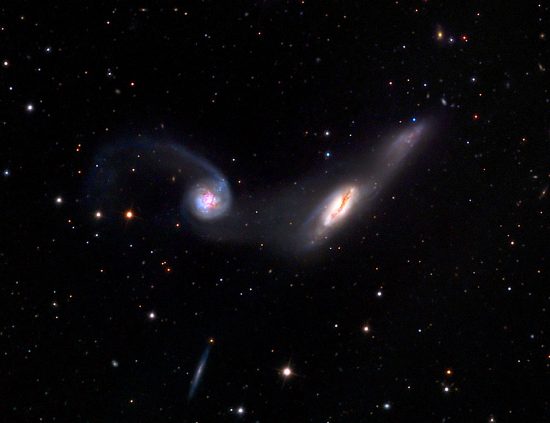Jun 21, 2018
Electricity moves the Universe.
“To try to write a grand cosmical drama leads necessarily to myth. To try to let knowledge substitute ignorance in increasingly larger regions of space and time is science.”
— Hannes Alfvén
The movement of electric charge through plasma-state material generates electromagnetic fields that align the flow. Picture of the Day articles describe that alignment as a Bennett pinch, or, more commonly, a z-pinch. Those constricted filaments of electricity remain coherent over great distances, forming helical power lines through space called, Birkeland currents.
Electrically active filaments are observed throughout the Universe. Planetary nebulae, for example, exhibit light-years-long strands that glow in infrared wavelengths, while many galaxies reveal optically bright, braided filaments; the visible portions of enormous electric circuits. Since electricity in space is not easily mapped, astronomers rely on their electromagnetic signatures, so galactic charge flows can be identified by their magnetic fields. It is manifestly true that no magnetic field can be created without an electrical impetus—it is, after all, electromagnetism.
Nobel laureate and plasma pioneer, Irving Langmuir was among the first to scrutinize the effects of charged particles moving through various gases. Based on those observations, he coined the term “plasma”, because what he saw appeared similar to the way that organic plasma isolates itself inside cells. Electrically charged regions in gases also tended to isolate themselves. Those discrete charged regions form double layers in plasma.
Double layers are oppositely charged parallel sheets that form electric fields, accelerating electrons and positive ions in opposite directions. Since moving electric charges are known as electricity, there is an electric current present. Large potential voltage drops between separated layers can be so powerful that electrons might reach “relativistic” velocities.
Hannes Alfvén, another Nobel Prize winner, wrote:
“The first decade of space research mainly concentrated on the exploration of space near the Earth: the magnetosphere and interplanetary space. These regions earlier were supposed to be void and structureless but we now know that they are filled with plasmas, intersected by sheathlike discontinuities, and permeated by a complicated pattern of electric currents and electric and magnetic fields. The knowledge gained in this way is fundamental to our general understanding of plasmas, especially cosmic plasmas.”
Electric forces can accelerate charged particles with energies of 10^20 electron volts or more. Laboratory experiments with particle accelerators confirm the observation.
According to a recent press release, “galactic winds” are responsible for the accumulation of heavy elements in the Milky Way, as well as their presence in intergalactic space. Astronomers find it “mysterious” when elements such as carbon or nickel are found in the voids between galaxies, since the theory of stellar evolution states that only fusion reactions inside stars can create elements heavier than helium. It is a principle of Big Bang physics that there was only hydrogen and helium when the Universe came into existence.
Researchers found “… two huge funnel-shaped jets of gas streaming out…from NGC 2992.” Since is is consensus science at work in the observatories, the explanation for those jets is black hole emissions.
In a previous Picture of the Day, similar funnel-shaped lobes of a gamma rays were discovered, extending out from the Milky Way’s central bulge. Each structure measures approximately 65,000 light-years in diameter. Based on the analysis in that article, the most likely phenomenon accelerating matter into space is electric double layers. Electricity streams out from galactic spin axes, creating double layers that appear as jets and lobes. The charge flow then spreads out, returning to the galactic core through its spiral arms. That is why the structures are shaped like funnels.
Radio waves are emitted from cosmic double layers over a broad band of frequencies. Double layers also sort material based on composition. As mentioned, they can accelerate charged particles up to cosmic ray energies. Rather than a mechanical cosmos, directed and powered by gravity and fluid dynamics, its electrical components are coupled to circuits with Birkeland currents. Those galactic circuits contain heavy elements within their filamentary forms.
Stephen Smith













